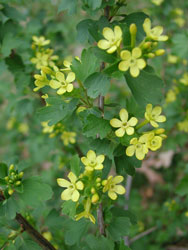Resource Library
Plant of the Week: Currant, Clove
The University of Arkansas System Division of Agriculture does not promote, support or recommend plants featured in "Plant of the Week." Please consult your local Extension office for plants suitable for your region.
Plant of the Week
Clove Currant
Latin: Ribes aureum

As gardeners, we have a seemingly endless choice of plants but only a limited amount of space. As with any resource allocation problem, we choose plants that give us the biggest bang for the buck. Maybe that is why clove currant (Ribes aureum var. villosum) isn’t seen more or maybe it’s because not enough people know about it.
Clove or golden currant (also often listed as Ribes odoratum) is a deciduous shrub growing to 6 feet tall which will spread horizontally by a series of arching upright branches to form a small thicket often wider than it is tall. Unlike some currants, this species is thornless. It produces three- and occasionally five-lobed blue-green leaves to 2 inches long that are produced on long petioles. In the fall leaves can turn yellowish orange before falling.
It is the spectacular flowers that are produced over a two- to three-week period in mid-spring that make this plant a must-have for those wishing to entertain all their senses. The bright yellow trumpet-shaped flowers have five prominent petals surrounding a small central corona. Individual blossoms are about a half-inch across and borne in terminal clusters of up to 20 blooms. The edible berries are black and about the size of a small blueberry.
The clove currant is best known for its fragrance that has a distinct smell of cloves and carnation. It most closely resembles the fragrance of Viburnum carlesii, but is a bit spicier. The fragrance is most pronounced in the afternoon.
There are about 150 species of currants scattered across the northern hemisphere. Long considered a part of the saxifrage family they now reside along with Itea in the Grossulariaceae family, which includes the Virginia Sweetspire. The currants commonly grown in gardens for their fruit include the black currant (R. nigrum), red currant (R. rubrum), jostaberry (R. x culverwellii) and the gooseberry (R. uva-crispa). The currants and gooseberries are more commonly grown in the northern and western states, not the South. In some northern states there are restrictions on planting these plants because they are the alternate host for the white pine blister rust.
The natural range of distribution of clove currant is from Minnesota to Texas and points west. Unlike most plants, the only place in the United States where this species is not native is the southeastern states. In the Ozarks it is found on south- and west-facing limestone outcrops indicating its preference for hotter and drier climes. Unlike most currants, the clove currant is very drought tolerant.
In the garden the clove currant is an excellent shrub for adding to a sunny mixed border or near a patio planting. It will tolerate light shade and still bloom. Though found in limestone areas it seems to grow well in more acidic conditions. Propagation is easy by means of lifting root suckers.
By: Gerald Klingaman, retired
Extension Horticulturist - Ornamentals
Extension News - March 19, 2010
The University of Arkansas System Division of Agriculture does not maintain lists of retail outlets where these plants can be purchased. Please check your local nursery or other retail outlets to ask about the availability of these plants for your growing area.